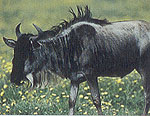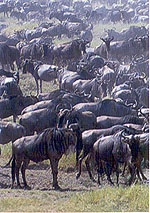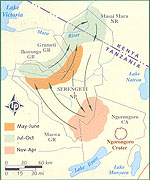WILDEBEEST



How to Recognize
Wildebeests are large antelopes with thick necks and shaggy horse-like manes and tails. Their elongated heads have a white beard, black muzzle, and cowlike horns. They are gray to tan in color with overall darker streaks.
Habitat and “The Migration”
“The Migration” is a famous 500-mile cycle of grazing, rutting, and calving that up to 1.5 wildebeest along with up to 200,000 zebras and 500,000 Thomson's gazelles partake in every year. They cross the Serengeti grasslands in Tanzania to the Masai Mara in Kenya in search of fertile land. The old and sick are left behind.
The mothers travel with their young toward the center, ‘single’ females further out, dominant males on the edge, and males trying to establish harems on the outside or trailing behind.
Behavior
Diurnal and nocturnal. During the rainy season, cows congregate with their young among the territorial bulls. Bulls give loud froglike belching grunts when displaying.
Breeding
After eight months of gestation, calving occurs between late January and mid-March (rainy season). Cows drop some 400,000 calves within a few weeks of each other which coincides with the new grass from the rains. The calves can walk and run within minutes after birth.
As conditions dry out, the migration begins which stimulates hormonal changes in both sexes. The cows come into estrus, and the bulls respond by staking tiny territories for a few days. They can be seen shaking their heads, cavorting, and leaping to get the attention of the cows. The bulls will mate with as many cows as it can before the herd moves on.
Feeding
Wildebeest are nomadic grazers, constantly moving in search of nutritious short green grass and water. They can't survive long on coarse grass. Because they prefer to drink daily and can survive only five days without water, wildebeest will migrate large distances to find it. Their wide mouth is suited to eat grass that is close to the ground. They chew their cud.
Enemies
Lions, cheetahs, hyenas, wild dogs, and crocodiles. Hundreds of wildebeest drown where bottlenecks form at river crossings.
TOP OF PAGE
Copyright © 2002, Dawn M. Dalton.
All rights reserved.
**LINKS**
WHERE?
WHY?
ITINERARY
PLAN YOUR TRIP
GETTING THERE
LONDON
KENYA
UGANDA
SAFETY
ITEMS BOUGHT
STAYING HEALTHY
COMMENTS
HOME
BHS HOME
---Animal Facts--
Baboon
Buffalo
Cheetah
Chimpanzee
Crocodile
Eland
Elephant
Gazelle
Giant Forest Hog
Giraffe
Gorilla
Hippopotamus
Hyena
Hyrax
Impala
Jackal
Lion
Mongoose
Monkey
Ostrich
Rhinoceros
Topi
Uganda Kob
Warthog
Waterbuck
Wildebeest
Zebra